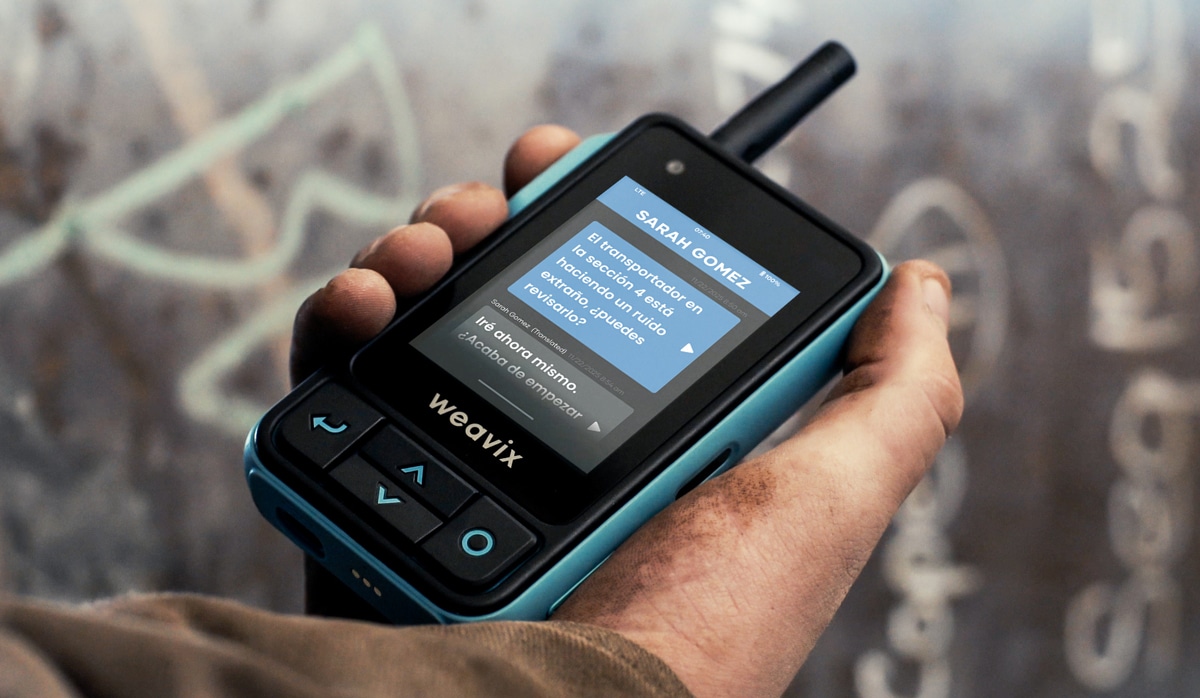Most plant managers face a serious bottleneck: outdated communication tools and fragmented systems hold back efficiency improvements on the production floor. While the pressure to adopt new technologies grows, many facilities struggle to connect their workforce, streamline processes, and maintain quality standards — all while keeping costs down.
In this guide, we break down how digital transformation in manufacturing reshapes everyday operations, which technologies deliver the fastest impact, and the practical steps plant leaders need to succeed in 2025.
Key highlights:
- Digital transformation in manufacturing is the adoption of advanced technologies, connected systems, and data-driven processes to improve efficiency, quality, and decision-making across the factory floor.
- In 2025, manufacturers are prioritizing digital transformation to reduce downtime, strengthen supply chains, and adapt to rapid market changes.
- The benefits of digital transformation in manufacturing include improved productivity, lower operating costs, safer working conditions, and greater workforce engagement.
- The Walt® Smart Radio System by weavix® helps plant managers and safety leaders bridge communication gaps, turning digital transformation goals into measurable frontline results.
What Is Digital Transformation in Manufacturing?
Digital transformation in manufacturing is the process of integrating advanced digital technologies into all facets of production and operations to enhance efficiency, innovation, and competitiveness. This transformation shifts traditional manufacturing processes toward more interconnected and intelligent systems, often referred to as smart manufacturing.
Key technologies driving this transformation include:
- Internet of Things (IoT): Deploying sensors and connected devices across the production floor enables real-time monitoring of equipment performance, environmental conditions, and product quality. This connectivity allows for predictive maintenance, reducing downtime and extending machinery lifespan.
- Artificial intelligence and machine learning: Utilizing AI algorithms to analyze vast datasets helps in optimizing production schedules, improving quality control, and forecasting demand. For instance, AI can predict equipment failures before they occur, allowing for proactive maintenance strategies.
- Cloud computing: Implementing cloud-based systems facilitates seamless data sharing and collaboration across departments and locations. This integration enhances decision-making processes and supports scalable operations without significant infrastructure investments.
- Automation and robotics: Incorporating automated systems and robotics streamlines repetitive tasks, increases production speed, and ensures consistent product quality. Advanced robotics can adapt to various tasks, enhancing flexibility in manufacturing processes.
By embracing these technologies, manufacturers can transition from isolated, manual operations to interconnected, data-driven processes, leading to improved operational efficiency, product quality, and responsiveness to market demands.
Learn also: What to consider when choosing a digital communication platform
Why Manufacturing Digital Transformation Matters in 2025
Manufacturing digital transformation matters in 2025 due to its profound impact on operational efficiency, cost reduction, and competitive positioning. By integrating advanced technologies, manufacturers can streamline processes, enhance product quality, and respond swiftly to market demands.
According to the PwC Digital Factory Transformation Survey, industrial companies worldwide are investing significantly in digital transformation, but progress is slow, with many companies still at the beginning stages of their digital transformation journey.
Key reasons for prioritizing digital transformation in manufacturing include:
- Operational efficiency: Implementing digital tools such as IoT sensors and machine learning algorithms enables real-time monitoring and automation of production processes.
- Cost reduction: Digital transformation facilitates predictive maintenance, reducing unplanned downtime and maintenance costs. Additionally, automation of repetitive tasks minimizes human errors, contributing to significant cost savings.
- Data-driven decision-making: Leveraging big data analytics allows manufacturers to make informed decisions, optimize supply chains, and forecast demand accurately.
- Enhanced customer experience: Digital tools improve product customization and delivery times, leading to an improvement in customer experience among manufacturers who have adopted digital transformation initiatives.
Embracing digitalization in manufacturing is not merely a trend but a strategic necessity in 2025. It empowers manufacturers to achieve higher efficiency, reduce costs, and deliver superior products, ensuring sustained competitiveness in a rapidly evolving market.

Benefits of Digital Transformation in Manufacturing
The benefits of digital transformation in manufacturing go beyond adopting new tools — they reshape how work gets done on the factory floor. By connecting machines, systems, and people through real-time data, manufacturers reduce downtime, improve quality, and create safer workplaces. This strategic shift offers several key advantages:
- Enhanced workplace safety: Implementing automation and robotics reduces human exposure to hazardous tasks, such as handling heavy machinery or toxic substances. For instance, predictive maintenance systems can identify equipment issues before they lead to accidents, thereby decreasing workplace injuries. These initiatives align with comprehensive safety solutions for modern industrial environments.
- Greater operational efficiency: Digital tools like the Industrial Internet of Things enable real-time monitoring and optimization of manufacturing processes. This leads to reduced downtime, minimized waste, and improved resource utilization.
- Better customer experience: By leveraging data analytics and automation, manufacturers can offer personalized products and faster delivery times. This responsiveness to customer needs enhances satisfaction and fosters loyalty.
- Stronger collaboration: Digital platforms facilitate seamless communication and collaboration across departments and with external partners. This interconnectedness ensures that all stakeholders are aligned, leading to more cohesive operations and quicker decision-making.
Embracing digital transformation equips manufacturing companies to navigate the complexities of the modern industrial landscape, driving growth and maintaining a competitive edge.
See also: Industrial digital transformation 101: How smart radios optimize your frontline
Digital Transformation Examples in Manufacturing
The best way to understand the impact of new technologies is to look at real-world applications. From predictive maintenance to AR-based training, these digital transformation examples in manufacturing highlight how companies are turning digital strategies into measurable results on the factory floor.
1. Digital Twins
Digital twins are virtual replicas of physical assets or processes, enabling real-time monitoring and simulation. For instance, Unilever has multiple advanced digital factories globally recognized by the World Economic Forum as “Lighthouse” sites, where they implement cutting-edge technologies including digital twins and IoT data integration for real-time monitoring and efficiency improvement.
These digital models simulate intricate scenarios to determine optimal operational parameters, leading to more precise material usage and reduced waste from products that don’t meet quality standards.
2. Augmented Reality for Training and Assembly
AR technology overlays digital information onto the physical world, enhancing training and assembly processes. BAE Systems, for example, employs AR glasses integrated with data systems like CAD and IoT to streamline complex component assembly.
This approach accelerates production timelines, minimizes errors, and reduces training periods through immersive experiences, ultimately improving product quality and compliance with industry standards for connected workers.
3. Predictive Maintenance With IoT and AI
Integrating IoT sensors with AI models enables predictive maintenance, reducing equipment downtime and operational costs. . By analyzing data from sensors, potential issues are identified before they lead to failures, ensuring continuous production and cost savings.
4. Robotic Process Automation (RPA)
RPA involves using robots and automated systems to handle repetitive tasks, increasing speed and precision while reducing human error. By automating tasks like assembly and quality control, human workers can focus on more complex activities, enhancing overall productivity.
5. AI for Real-Time Communication
Artificial intelligence is also increasingly being built into frontline communication tools, helping manufacturers share information quickly and accurately. One example is the use of smart radios, which combine traditional push-to-talk functionality with AI features like real-time translation and automated alerts.
These capabilities allow multilingual crews to collaborate seamlessly, give supervisors instant visibility into safety incidents, and ensure decisions can be made without delay. The result is faster problem-solving and stronger alignment across every shift.
Learn more: AI translation: How artificial intelligence transforms manufacturing and construction
Challenges of Digital Transformation in Manufacturing — and How to Address Them
The challenges of digital transformation in manufacturing often come down to more than just technology. Manufacturers face obstacles like high implementation costs, resistance to change, legacy systems that don’t integrate easily, and gaps in workforce skills.
Legacy Systems and Infrastructure
Many manufacturers rely on legacy systems that may not easily integrate with new digital solutions. These outdated systems can slow down the adoption of modern technologies.
Companies need a clear strategy for system integration, ensuring that new technologies work seamlessly with or replace existing ones without disrupting production. Often, an industrial radio system may be part of this outdated infrastructure.
To address this, manufacturers should:
- Conduct comprehensive system audits: Evaluate existing infrastructure to identify integration challenges and plan necessary upgrades.
- Develop integration strategies: Implement middleware solutions or APIs that facilitate communication between legacy systems and new technologies.
- Plan for phased implementation: Gradually replace outdated systems to minimize operational disruptions and manage costs effectively.
High Initial Costs
Implementing digital technologies like IoT, AI, and robotics requires significant financial investment. These costs encompass new equipment, software, training, and potential downtime during system upgrades.
To mitigate financial strain:
- Prioritize high-impact projects: Focus on initiatives with clear, measurable benefits to ensure a favorable return on investment.
- Explore financing options: Seek grants, subsidies, or partnerships to offset initial expenses.
- Implement cost-benefit analyses: Regularly assess the financial impact of digital initiatives to guide resource allocation on your budget for digital transformation.
Workforce Skill Gap and Adoption
A significant challenge for digital transformation in the manufacturing industry is ensuring that the workforce possesses the necessary skills to operate and maintain new digital tools. Resistance to change and a lack of adequate training can hinder the successful adoption of new technologies. This directly impacts overall frontline technology adoption.
To overcome this:
- Invest in training programs: Develop comprehensive training initiatives that provide employees with the skills needed for new digital tools.
- Foster a culture of learning: Encourage continuous learning and upskilling to keep pace with technological advancements.
- Involve employees early: Engage the workforce in the planning and implementation phases to build buy-in and reduce resistance.
Scalability
Ensuring that digital transformation efforts can scale with business growth is crucial. Implementing technologies that cannot adapt to increased demand or evolving processes can lead to inefficiencies and additional costs.
To ensure scalability:
- Adopt modular solutions: Choose technologies that allow for incremental upgrades and expansions.
- Plan for future growth: Design digital transformation strategies with long-term scalability in mind, considering potential market changes and business objectives.
- Regularly review and update systems: Continuously assess and refine digital systems to align with evolving business needs and technological advancements.
By proactively addressing these challenges, manufacturers can navigate the complexities of digital transformation, leading to enhanced efficiency, competitiveness, and long-term success.
7 Steps to Digital Transformation in Manufacturing
Digital transformation requires a structured approach that connects new technologies with day-to-day operations. These seven steps to digital transformation in manufacturing outline how leaders can modernize processes, strengthen workforce performance, and achieve measurable results on the factory floor.
1. Identify Operational Gaps
Begin by conducting a comprehensive assessment of current operations to pinpoint inefficiencies and areas for improvement. This involves analyzing production workflows, supply chain logistics, and quality control processes to identify bottlenecks and waste.
For example, a manufacturer might discover that outdated machinery leads to frequent downtime, affecting overall productivity. Addressing these gaps lays the foundation for targeted digital interventions.
2. Engage the Workforce Early
Involving employees from the outset ensures smoother adoption of new technologies. Transparent communication about the objectives and benefits of digital transformation fosters a culture of innovation and reduces resistance. Providing training programs equips staff with the necessary skills to operate new systems effectively.
For instance, a company implementing an Industrial Internet of Things platform can offer workshops to familiarize employees with data analytics tools, enhancing their ability to make data-driven decisions.
3. Choose Technologies That Integrate With Existing Systems
Selecting digital solutions that seamlessly integrate with current infrastructure minimizes disruptions and maximizes return on investment. Prioritize technologies that enhance existing processes, such as adding sensors to legacy equipment for real-time monitoring.
This approach allows for incremental improvements without the need for complete system overhauls, facilitating a more manageable transition. Consider robust manufacturing communication systems that bridge old and new technologies.
4. Develop Workforce Skills for Digital Tools
Investing in continuous education ensures that employees remain proficient with evolving digital tools. Tailored training programs can address specific needs, such as teaching maintenance staff predictive maintenance techniques using AI algorithms. By upskilling the workforce, manufacturers enhance operational efficiency and empower employees to contribute to innovation initiatives.
5. Implement Security Protocols
As digital systems become more integrated, robust cybersecurity measures are crucial to protect sensitive data and maintain operational integrity. Develop comprehensive security protocols that include regular system audits, employee training on cybersecurity best practices, and the implementation of advanced threat detection systems.
For example, establishing multi-factor authentication and encryption protocols can safeguard against unauthorized access and data breaches.
6. Evaluate Performance and ROI
Regularly assessing the impact of digital initiatives ensures they deliver the desired outcomes. Establish key performance indicators to measure improvements in areas such as production efficiency, product quality, and cost reduction.
For instance, tracking the reduction in machine downtime after implementing predictive maintenance can quantify the return on investment and guide future digital strategies.
7. Adapt Based on Performance Results
Use performance data to refine and adjust digital transformation strategies. Continuous improvement involves analyzing results, identifying successful initiatives, and scaling them while addressing areas that did not meet expectations. This iterative approach ensures that digital transformation efforts remain aligned with business objectives and adapt to evolving market demands.
Manufacturing Communication and Digital Transformation Readiness Assessment
Evaluate your manufacturing facility’s communication infrastructure and readiness for digital transformation. Answer each question honestly, then calculate your total score to discover where you stand.
Manufacturing Communication and Digital Transformation Readiness Assessment
Evaluate your manufacturing facility’s communication infrastructure and readiness for digital transformation. Answer each question honestly, then calculate your total score to discover where you stand.
The Connected Manufacturing Maturity Model: A Framework for Progressing from Basic Communication to Intelligent Manufacturing Systems
Communication is a big part of digital transformation in manufacturing. It often determines how effectively new technologies can be adopted and scaled across the workforce.
Most manufacturing facilities exist somewhere along a communication maturity spectrum. Understanding where you currently stand — and what the next level looks like — is crucial for planning your digital transformation roadmap. This five-stage maturity model helps manufacturing leaders assess their current communication infrastructure and chart a clear path toward fully connected operations.
Stage 1: Basic Radio Communication
“Isolated Voice-Only Systems”
Characteristics:
- Analog two-way radios with limited range
- Voice-only communication between workers
- No integration with plant systems
- Manual processes for emergency procedures
- Separate communication silos by department
- No data capture or communication analytics
Typical Challenges:
- Communication dead zones throughout facility
- Inability to reach all workers simultaneously
- No record of critical communications
- Difficulty coordinating between shifts and departments
- Limited emergency response capabilities
- High potential for miscommunication
Technology Stack:
- Basic analog or digital radios
- Separate paging systems
- Manual log books
- Paper-based shift reports
- Standalone safety systems
Assessment Questions:
- Do you rely primarily on handheld radios for worker communication?
- Are there areas in your facility with poor or no radio coverage?
- Do you manually track communication incidents and equipment issues?
- Is emergency communication limited to overhead announcements?
Stage 2: Digital Communication Systems
“Standardized Digital Connectivity”
Characteristics:
- Digital two-way radio systems with clear audio
- Improved coverage across facility areas
- Basic text messaging capabilities
- Some integration with safety systems
- Standardized communication protocols
- Digital record-keeping for some communications
Improvements Over Stage 1:
- Clearer audio quality and extended range
- Basic data transmission capabilities
- Improved emergency alert systems
- Digital logging of some communications
- Better battery life and device reliability
Remaining Limitations:
- Limited integration with production systems
- No real-time location tracking
- Minimal data analytics capabilities
- Communication still largely reactive
- Basic reporting and performance metrics
Technology Stack:
- Digital mobile radio (DMR) systems
- Basic text messaging platforms
- Digital emergency notification systems
- Simple communication logs
- Standardized radio protocols
Next Level Indicators:
- You need better coordination between communication and production data
- Workers request more flexibility in communication devices
- Management wants visibility into communication patterns and efficiency
Stage 3: Integrated Communication Platforms
“Connected Communication Ecosystem”
Characteristics:
- Unified communication platform across multiple device types
- Integration with manufacturing execution systems (MES)
- Real-time worker location awareness
- Automated alerts triggered by production events
- Cross-platform messaging (radio, mobile, desktop)
- Basic analytics and reporting on communication patterns
Key Capabilities:
- Device Flexibility: Workers can communicate via radios, smartphones, tablets, or desktop computers
- System Integration: Communication platform connects with ERP, MES, and safety systems
- Intelligent Routing: Messages automatically directed to appropriate personnel based on roles and location
- Event-Driven Communication: Automated alerts for equipment alarms, quality issues, and safety incidents
- Documentation: Comprehensive logging of all communications for compliance and analysis
Technology Stack:
- Smart radio systems with IoT capabilities
- Unified communication software platforms
- Integration APIs with existing plant systems
- Cloud-based communication management
- Mobile applications for supervisors and management
Business Impact:
- 25-40% reduction in response times to equipment issues
- Improved shift handover efficiency and accuracy
- Enhanced compliance documentation and audit trails
- Better coordination during maintenance and quality events
- Reduced communication-related safety incidents
Assessment Questions:
- Can workers seamlessly switch between communication devices during their shifts?
- Do production alerts automatically notify the right personnel?
- Can supervisors see real-time status of worker communications and locations?
- Are communication patterns analyzed to improve operational efficiency?
Stage 4: AI-Enhanced Communication
“Intelligent Communication Orchestration”
Characteristics:
- AI-powered communication routing and prioritization
- Predictive communication based on operational patterns
- Advanced analytics with actionable insights
- Automated translation and language support
- Voice-to-text and natural language processing
- Integration with predictive maintenance systems
Advanced Capabilities:
- Intelligent Escalation: AI determines when and how to escalate communications based on context and urgency
- Predictive Alerts: System anticipates communication needs based on production schedules and historical patterns
- Communication Analytics: Advanced reporting on communication effectiveness, response times, and operational impact
- Natural Language Processing: Voice commands and automated transcription of critical communications
- Contextual Messaging: Communications include relevant production data, schematics, and historical information
Technology Stack:
- AI-powered communication platforms
- Machine learning algorithms for pattern recognition
- Advanced analytics and business intelligence tools
- Natural language processing capabilities
- Predictive maintenance integration
- Advanced IoT sensor networks
Business Impact:
- 40-60% improvement in first-time problem resolution
- Proactive communication prevents 70%+ of routine escalations
- Significant reduction in communication noise and interruptions
- Enhanced decision-making through data-enriched communications
- Improved worker productivity through intelligent information delivery
Innovation Examples:
Maintenance alerts automatically include equipment history, spare parts availability, and technician expertise matching
Quality issues trigger communications that include relevant production data, batch information, and corrective action protocols
Safety incidents initiate coordinated response with automated notifications to emergency services, management, and relevant personnel
Stage 5: Predictive Communication Systems
“Autonomous Communication Intelligence”
Characteristics:
- Fully autonomous communication orchestration
- Predictive communication prevents issues before they occur
- Self-optimizing communication networks
- Advanced human-AI collaboration interfaces
- Continuous learning and system evolution
- Seamless integration with autonomous manufacturing systems
Cutting-Edge Capabilities:
- Autonomous Problem Resolution: System identifies and resolves many communication and coordination issues without human intervention
- Predictive Workforce Management: AI predicts optimal communication patterns and worker positioning based on production forecasts
- Self-Healing Networks: Communication infrastructure automatically adapts and optimizes based on usage patterns and environmental conditions
- Continuous Optimization: Machine learning continuously improves communication effectiveness and operational outcomes
- Digital Twin Integration: Communication systems fully integrated with digital twins for predictive modeling and simulation
Technology Stack:
- Advanced AI and machine learning platforms
- Autonomous communication orchestration systems
- Digital twin integration platforms
- Edge computing for real-time processing
- Advanced sensor networks and IoT ecosystem
- Quantum-enhanced communication security
Business Impact:
- Near-elimination of communication-related operational disruptions
- Predictive communication prevents 90%+ of potential issues
- Autonomous optimization delivers continuous efficiency improvements
- Human workers focus on high-value strategic and creative tasks
- Manufacturing operations approach autonomous optimization
Future Vision:
- Communication systems anticipate needs before humans recognize them
- Seamless human-AI collaboration optimizes both individual and system performance
- Manufacturing communication becomes invisible infrastructure that just works
- Continuous evolution and learning drive perpetual improvement
Assessing Your Current Maturity Level
Maturity Assessment Checklist
Stage 1 Indicators:
- Primary communication is analog/basic digital radios
- Frequent communication dead zones or coverage gaps
- Manual logging and documentation processes
- Limited emergency notification capabilities
- Communication systems operate independently
Stage 2 Indicators:
- Digital radio systems with clear audio quality
- Basic text messaging and data capabilities
- Improved facility coverage and reliability
- Digital emergency notification systems
- Some standardization of communication protocols
Stage 3 Indicators:
- Multiple communication device options for workers
- Integration between communication and production systems
- Real-time location awareness and tracking
- Automated alerts based on operational events
- Communication analytics and performance reporting
Stage 4 Indicators:
- AI-powered communication routing and prioritization
- Predictive communication based on operational patterns
- Advanced analytics with actionable business insights
- Natural language processing and voice recognition
- Integration with predictive maintenance and quality systems
Stage 5 Indicators:
- Autonomous communication orchestration
- Predictive communication prevents operational issues
- Self-optimizing communication networks
- Digital twin integration for communication modeling
- Continuous learning and system evolution
Your Advancement Roadmap for Digitalization in Manufacturing
From Stage 1 to Stage 2
Priority Actions:
- Upgrade to digital radio infrastructure with full facility coverage
- Implement standardized communication protocols and training
- Establish digital logging and documentation systems
- Improve emergency notification capabilities
- Timeline: 3-6 months
- Investment Level: Moderate
- Expected ROI: 15-25% improvement in communication reliability
From Stage 2 to Stage 3
Priority Actions:
- Deploy unified communication platform supporting multiple devices
- Integrate communication systems with MES and ERP systems
- Implement real-time location tracking and worker awareness
- Establish communication analytics and performance monitoring
- Timeline: 6-12 months
- Investment Level: Significant
- Expected ROI: 25-40% improvement in operational efficiency
From Stage 3 to Stage 4
Priority Actions:
- Implement AI-powered communication routing and prioritization
- Deploy predictive communication capabilities
- Integrate with predictive maintenance and quality systems
- Establish advanced analytics and continuous improvement processes
- Timeline: 12-18 months
- Investment Level: High
- Expected ROI: 40-60% improvement in operational effectiveness
From Stage 4 to Stage 5
Priority Actions:
- Deploy autonomous communication orchestration systems
- Integrate with digital twin and simulation platforms
- Implement continuous learning and optimization capabilities
- Establish human-AI collaboration interfaces
- Timeline: 18-24 months
- Investment Level: Very High
- Expected ROI: Transformational operational improvements
Getting Started: Your Next Steps
Immediate Actions (Next 30 Days):
- Assess Your Current Stage: Use the indicators above to honestly evaluate your current maturity level
- Identify Quick Wins: Look for immediate improvements within your current stage
- Calculate Communication ROI: Quantify the business impact of communication delays and inefficiencies
- Build Stakeholder Support: Present maturity model and business case to leadership
Planning Phase (30-90 Days):
- Define Target State: Determine your desired maturity level within 12-24 months
- Develop Roadmap: Create detailed timeline and resource requirements for advancement
- Evaluate Solutions: Research communication platforms that support your target maturity level
- Plan Pilot Programs: Identify low-risk areas for initial implementation and testing
Implementation Considerations:
- Start with Safety: Prioritize communication improvements that enhance worker safety
- Focus on Integration: Choose solutions that work with your existing systems
- Plan for Scalability: Ensure your chosen platform can grow with your maturity goals
- Invest in Training: Worker adoption is critical for realizing communication improvements
- Measure Progress: Establish KPIs to track advancement through maturity stages
Smart Radio ROI Calculator Worksheet: Calculate Your Return on Investment for Manufacturing Communication Upgrades
Use this step-by-step worksheet to quantify the financial impact of upgrading to an integrated smart radio communication system. Complete each section with your facility’s actual data to determine your potential ROI and payback period.
Click here to download the ROI calculator worksheet

Kickstart Manufacturing Digital Transformation with the Walt Smart Radio System
Unlock the full potential of digital transformation in manufacturing with the Walt Smart Radio System® by weavix®. This intelligent platform goes beyond traditional radios, delivering seamless, real-time communication that connects every worker on your plant floor — no matter where they are or what device they use.
The system is rugged, waterproof, and designed for harsh industrial environments, so your workforce stays safe and informed. Continuous over-the-air updates ensure the Walt Smart Radio System remains at the forefront of workplace technology, supporting evolving production needs and integrating with your broader digital initiatives.
Strong, instant communication is the foundation of any successful transformation effort. With unified safety, reliability, and ease of use, the Walt Smart Radio System gives plant managers the tools to drive operational efficiency, reduce downtime, and promote a safety-first culture.
Ready to see it in action? Contact us to discuss your needs, or visit our request a demo page to experience the Walt Smart Radio System firsthand.
Frequently Asked Questions
What are the main drivers for digital transformation in manufacturing?
The main drivers for digital transformation in manufacturing are the increasing demands for efficiency, competitiveness, and agility in a rapidly evolving global market. Manufacturers face pressure to reduce costs, improve product quality, and accelerate time-to-market.
Digital technologies like IoT, AI, and cloud computing offer solutions to these challenges by enabling real-time data analysis, automation, and improved decision-making.
Furthermore, customer expectations for personalized products and faster delivery also push manufacturers toward digital adoption. The need for enhanced workplace safety and attracting a younger, tech-savvy workforce are additional factors compelling industrial leaders to embrace digital transformation.
How does digital transformation impact the manufacturing workforce?
Digital transformation impacts the manufacturing workforce by altering job roles, requiring new skill sets, and improving worker safety and collaboration. While automation may change some manual tasks, it also creates new opportunities in areas such as data analysis, AI system management, and cybersecurity. Workers need to adapt by acquiring digital literacy and specialized technical skills.
Beyond skills, digital tools enhance the frontline worker experience. Technologies like smart radios facilitate seamless communication, while predictive maintenance systems reduce exposure to hazardous situations. This transformation ultimately leads to a more efficient, safer, and technologically advanced work environment for all employees.




